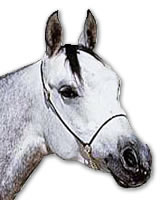How To Set A Horse's Head

The ideal horse caput conformation varies dramatically from breed to breed, but all breeds are valued for a relatively broad forehead.
A wide forehead provides increased sinus capacity, thus at that place is more than room for air exchange through the air passages, and a big surface expanse for facial muscles that assist in opening the nostrils for good air flow.
A practiced head in any brood must also have big optics, proportionate ears, large nostrils, practiced width between the jaws, and a smooth joining of the head to the neck.
A wide jaw or throatlatch allows more than 4 fingers between jaw bones (greater than 7.2 cm wide) A broad throatlatch may make a head appear less flexible, but really it has no effect on the horse accepting the bit and does not restrict air flow. The horse is proficient for any activeness.
The ability to breathe deeply is disquisitional to the success of a horse in whatever endeavor, so whatever conformation flaw that restricts breathing capacity is a fault across all breeds.
Horse heads that distinguish equus caballus breed types:

Dished face:
The horse has a concave profile or dish beneath the eyes, often further exaggerated by slight bulging of the brow (jibbah)
Contrary to popular conventionalities, a deep dish in and of itself does not restrict airflow, rather, it allows for long periods of aerobic activity, such as Endurance riding.
This type of head is seen in light riding horses such equally the Arab horse.

Roman Nose:
The horse has a convex profile.
Properly proportioned, this blazon of caput has acceptable sinus capacity.
particularly suited for sustained bursts of power such as that needed by Draft horses and lighter riding breeds noted for their power.
The fine quality Andalusian pictured above right, exhibits a roman nose.
Equus caballus head conformation faults include:
Small Nostrils :
Opening of the nostrils (the nares) is narrow and somewhat restricted, limiting ability to expand the nostrils for animate while working difficult. Small Nostrils tin occur in any breed.
Information technology especially affects horses in high-speed activities (polo, racing, eventing, steeplechase) or those that need sustained endeavor over a long duration (endurance, competitive trial, combined driving). These horses are therefore best for pleasure-riding or non-speed sports
Often seen in horses that also take narrow jaws and muzzle
Overshot Jaw (parrot oral fissure) or Undershot Jaw (sow rima oris)
The upper jaw extends further out than the lower jaw, with the horse having an overbite (parrot rima oris).
Or the lower jaw extends further out than the upper jaw, with the equus caballus having an underbite (sow rima oris).
- Both defects tin can affect the chewing of the equus caballus and the horse's ability to prune grass.
- Both defects are fairly rare.
Narrow Throatlatch or Jaw :

A throatlatch is narrow if it measures less than vii.2 cm (the average for Thoroughbreds)
This is a mutual fault, seen mostly in thoroughbreds, standardbreds, racing and speed horses who compete in horse racing, steeplechase, eventing and polo.
The horse may suffer from restricted upper airway or air turbulence due to paralysis of recurrent laryngeal nerve (RLN).
Horses with paralysis of one or both cartilages make a roaring sound when working at fast speeds
This is because the cartilage collapses into the airway space. This causes exercise intolerance, and may lead to stops at a fence due to muscular fatigue.
May be associated with bleeders (practise induced pulmonary hemorrhage- EIPH)
A dressage horse or horse that needs to continue the bit in a nerveless frame may exist resistant to do so considering flexing at the poll further narrows the airway. Withal, the horse does non necessarily showroom a roaring sound.
Symptoms include: resistance to bridle, bracing through the poll, neck, and back, difficulty in grooming to the upper levels.
A equus caballus with a narrow throatlatch is best for work that does not require high speeds
Source: https://www.localriding.com/horse-head-conformation.html

0 Response to "How To Set A Horse's Head"
Post a Comment